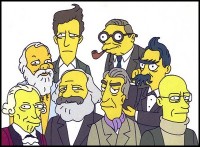Do subatomic particles have free will?
http://www.sciencenews.org/view/generic/id/35391/title/Do_subatomic_particles_have_free_will%3F
Do subatomic particles have free will?
By Julie Rehmeyer
If we have free will, so do subatomic particles, mathematicians claim to prove.
If the atoms never swerve so as to originate some new movement that will snap the bonds of fate, the everlasting sequence of cause and effect—what is the source of the free will possessed by living things throughout the earth?”—Titus Lucretius Carus, Roman philosopher and poet, 99–55 BC.
Human free will might seem like the squishiest of philosophical subjects, way beyond the realm of mathematical demonstration. But two highly regarded Princeton mathematicians, John Conway and Simon Kochen, claim to have proven that if humans have even the tiniest amount of free will, then atoms themselves must also behave unpredictably.
The finding won’t give many physicists a moment’s worry, because traditional interpretations of quantum mechanics embrace unpredictability already. The best anyone can hope to do, quantum theory says, is predict the probability that a particle will behave in a certain way.
But physicists all the way back to Einstein have been unhappy with this idea. Einstein famously grumped, “God does not play dice.” And indeed, ever since the birth of quantum mechanics, some physicists have offered alternate interpretations of its equations that aim to get rid of this indeterminism. The most famous alternative is attributed to the physicist David Bohm, who argued in the 1950s that the behavior of subatomic particles is entirely determined by “hidden variables” that cannot be observed.
Conway and Kochen say this search is hopeless, and they claim to have proven that indeterminacy is inherent in the world itself, rather than just in quantum theory. And to Bohmians and other like-minded physicists, the pair says: Give up determinism, or give up free will. Even the tiniest bit of free will.
Their argument starts with a proof Kochen created with Ernst Specker 40 years ago. Subatomic particles have a property called “spin,” which occurs around any axis. Experiments have shown that a type of subatomic particle called a “spin 1 particle” has a peculiar property: Choose three perpendicular axes, and prod the spin 1 particle to determine whether its spin around each of those axes is 0. Precisely one of those axes will have spin 0 and the other two will have non-zero spin. Conway and Kochen call this the 1-0-1 rule.
Spin is one of those properties physicists can’t predict in advance, before prodding. Still, one might imagine that the particle’s spin around any axis was set before anyone ever came along to prod it. That’s certainly what we ordinarily assume in life. We don’t imagine, say, that a fence turned white just because we looked at it — we figure it was white all along.
But Kochen and Specker showed that this assumption — that the fence was white all along — can’t hold in the bizarre world of subatomic particles. They used a pure mathematical argument to show that there is no way the particle can choose spins around every imaginable axis in a way that is consistent with the 1-0-1 rule. Indeed, there is a set of just 33 axes that are enough to force the particle into a paradox. It could choose spins around the first 32 axes that conform with the rule, but for the last, neither 0 nor non-zero would do. Choosing zero spin would create a set of three perpendicular axes with two zeroes, and choosing non-zero spin would create a different set of three perpendicular axes with three non-zeroes, breaking the 1-0-1 rule either way.
This means that the particle cannot have a definite spin in every direction before it’s measured, Kochen and Specker concluded. If it did, physicists would be able to occasionally observe it breaking the 1-0-1 rule, which never happens. Instead, it must “decide” which spin to have on the fly.
Conway compares the situation to the game “Twenty Questions.” If you play the game fairly, you decide upfront on a single object and honestly answer each of the questions, hoping your opponent won’t deduce what you chose. But a clever player could also cheat, changing the object partway through. In that case, his answers aren’t determined in advance. The particle, Kochen and Specker showed, is like a cheating player. They found it out by showing that no single object satisfies all the “questions” (or all 33 axes) at once.
But there’s another possible interpretation. Perhaps the particle’s spin is completely determined — but depends on something else about the state of the universe. That would be like a player in “Twenty Questions” who has decided his object is a donkey whenever his opponent starts a question with “Is,” and that his object a horse otherwise (or using any other arbitrary but consistent rule). For example, if his opponent asked, “Is it something with big ears?” he would say “yes,” but if his opponent asked, “Does it have big ears?” he’d say “no.” In that case, his answers are predetermined even though he has no single object in mind.
Conway and Kochen say that they have now proven that particles’ responses can’t be pre-determined, even within this possible interpretation. “We can really prove that there’s no algorithm, no way that the particle can give an answer that is unique and can be specified ahead of time,” Conway says. “I’m still amazed that we can actually manage to prove that.”
They concocted a thought experiment for their proof. It is possible to entangle two spin 1 particles so that their spins are identical along every possible axis and will remain so, even if they are separated very far apart. Entangle two particles this way, and then send a physicist named Alice with one of them to Mars and leave the other with a physicist named Bob on Earth. That will prevent information from passing between the physicists or the particles, according to relativity theory. Alice and Bob each prod their particles along some axis, which they freely choose. If Alice and Bob happen to choose the same axis, they’ll get the same answer.
Now, imagine that the particles are like the “20 questions” player whose object is sometimes a donkey and sometimes a horse, with a fixed rule deciding when to answer with which animal. Whatever the rule is, it applies to each of the entangled particles and will cause them to have the same spins. It’s as if the “20 questions” player has been cloned, and both players are forced to give answers for the same animal.
But Conway and Kochen have shown this scenario is impossible for particles that are incommunicado. They invoked the old Kochen-Specker paradox to show that if the spin 1 particle’s behavior is pre-determined so that it isn’t allowed to “change its animal,” it won’t be able to give answers that are consistent with the 1-0-1 rule. So if Alice and Bob are lucky in how they choose their axes, they should be able to force the particles either to disagree or to violate the 1-0-1 rule — contrary to experimental evidence.
Kochen and Conway say the best way out of this paradox is to accept that the particle’s spin doesn’t exist until it’s measured. But there’s one way to escape their noose: Suppose for a moment that Alice and Bob’s choice of axis to measure is not a free choice. Then Nature could be conspiring to prevent them from choosing the axes that will reveal the violation of the rule. Kochen and Conway can’t rule that possibility out entirely, but Kochen says, “A man on the street would say, ‘Don’t be ridiculous.’ A natural feeling is, of course, that what we do, we do of our own free will. Not completely, but certainly to the point of knowing we can choose what button to push in an experiment.”
Ideally, a mathematical proof settles all uncertainty, but Kochen and Conway haven’t yet managed to convince many of the physicists they are addressing. “I’m not convinced,” says Sheldon Goldstein of Rutgers University, a Bohmian. He believes the argument implies nothing new, and he’s content with the notion that free will exists only effectively (not theoretically). He and his collaborators have spent many hours discussing these issues with the pair of mathematicians since Kochen and Conway first posted their result four years ago. Their new version, posted on Arxiv.org July 21, attempts to strengthen the result in light of criticisms. Still, mutual understanding has not yet come about. “It’s kind of depressing when people can’t communicate with each other,” Goldstein says. “We know that’s true in politics, but you’d think that wouldn’t be going on here.”
But Gerard ‘t Hooft of the University of Utrecht in the Netherlands, who won the Nobel Prize in physics in 1999, says the pair’s conclusions are legitimate — but he chooses determinism over free will. “As a determined determinist I would say that yes, you bet, an experimenter’s choice what to measure was fixed from the dawn of time, and so were the properties of the thing he decided to call a photon,” ‘t Hooft says. “If you believe in determinism, you have to believe it all the way. No escape possible. Conway and Kochen have shown here in a beautiful way that a half-hearted belief in pseudo-determinism is impossible to sustain.”










